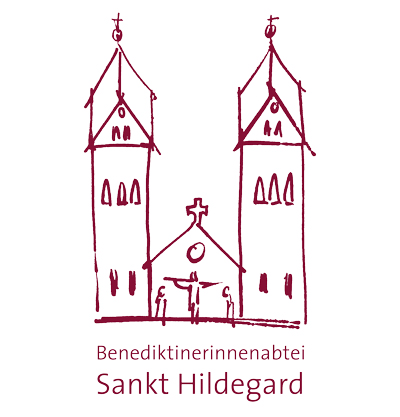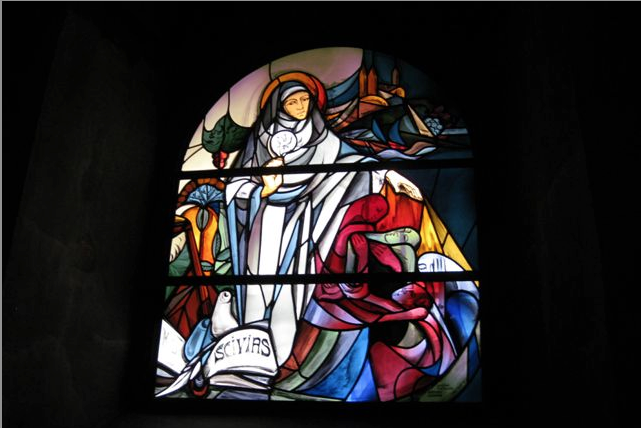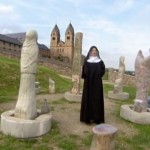Hildegard of Bingen – A Chronology of her Life and the History of her Canonization
1098
Hildegard is born at Bermersheim, near Alzey, south-west of Mainz.
ca. 1106
Hildegard is placed in the care of Jutta of Sponheim to be educated.
1 Nov 1112
Jutta and Hildegard enter an enclosure attached to the Benedictine monastery of Disibodenberg.
1136
After the death of Jutta, Hildegard is chosen by the convent, which had grown from the enclosure, to lead them as ‘magistra’.
1141 – 1151
Hildegard writes Scivias, her main work, composes numerous songs and the mystery play Ordo Virtutum.
1147 – 1179
Extensive correspondence with popes, bishops, secular leaders, monastic communities, clergy and lay people.
1147 / 1148
Hildegard’s writings are approved by Pope Eugenius III who himself reads from Scivias at the Synod of Trier.
1150
Hildegard founds an independent monastery and moves with twenty nuns to Rupertsberg near Bingen.
1158 – 1170
Hildegard preaches a number of public sermons, i.e. at Mainz, Würzburg, Bamberg, Trier, Metz and Cologne.
1158 – 1173
Hildegard writes the Liber vitae meritorum, compiles her medical work known as Physica and Causae et curae and writes the Liber divinorum operum.
1165
Hildegard founds a second monastery, Eibingen, on the hillside above Rüdesheim on the east bank of the Rhine. She is abbess of both monasteries, Rupertsberg and Eibingen.
1174 – 1175
The monk Gottfried begins to write the Life of Hildegard.
1178
Dispute with the diocesan administrators of Mainz, an interdict is imposed on Rupertsberg.
17 Sep 1179
Hildegard dies at Rupertsberg, just a few months after the interdict has been lifted. She is buried in front of the altar in the monastic church.
1180 – 1190
The monk Theodoric completes the Life of Hildegard, begun by Gottfried.
1226
The abbess and convent of Rupertsberg petition for the canonization of their founding abbess, Hildegard of Bingen.
27 Jan 1227
Pope Gregory IX initiates the canonization process.
1233
The priest Bruno, Custos of St Peter’s at Strasbourg, takes the canonization protocol, sealed on 6 December 1233 at Rupertsberg, to Rome, together with a copy of the Life of Hildegard, her writings and an assessment of her work, issued by the Theological Faculty of the University of Paris, which William of Auxerre summarizes in this way: “Hildegard’s writings do not contain human, but divine words.”
1237
The canonization protocol is rejected, as it does not meet the formal requirements – exact details concerning the specified miracles, such as dates, places, names of both witnesses and those persons who were healed, are apparently insufficient.
6 May 1237
Pope Gregory IX charges a new commission with the process; amongst its members are the Dean, Master Scholastic and Canon Walter of the Chapter of Mainz Cathedral. It is presumed that this commission never took up its work.
24 Nov 1243
Pope Innocence IV makes a fresh attempt during the first year of his pontificate to carry the canonization process forward. The original protocol is revised, containing several amendments and additions. Nowadays, the canonization protocol of 1233 and the revised version of 1243 are preserved in the main Public Records Office of the city of Koblenz.
From 1243
Hildegard’s canonization process remains pending.
26 Aug 1326
The monastery of Rupertsberg is granted several indulgences by Pope John XXII who makes mention of ‘the Feast Day of Saint Hildegard’. This is the first papal document, which officially refers to Hildegard as a saint.
1489
The archbishop of Mainz, Berthold von Henneberg, attempts to set the canonization process in motion again. In the hope of finding canonization documents, he orders Hildegard’s grave to be opened, but his hope is unfounded. Hildegard’s remains are placed in a new shrine.
1493
The printed World Chronicle of the Nuremberg humanist Hartmann Schedel, richly illustrated with woodcuts, mentions Hildegard at length and thus acquaints her with a broad readership.
1498
Trithemius, Abbot of Sponheim, has Hildegard’s grave re-opened. But again, no documents of former times relating to the canonization process are found.
15th century
Hildegard of Bingen is entered in the Martyrologium Romanum, the catalogue of saints of the Roman Catholic Church, where it is recorded on 17 September: Apud Bingiam, in dioecesi Moguntinensi, sanctae Hildegardis virginis. (Near Bingen, in the diocese of Mainz, memorial of the holy virgin Hildegard).
1632
The monastery of Rupertsberg is destroyed by the Swedes during the Thirty Years’ War. The nuns of Rupertsberg escape to Eibingen, taking the shrine with Hildegard’s remains with them.
1802
Dissolution of the monastery of Eibingen during the Secularization. In 1831 the former monastic church becomes the parish church of Eibingen.
17 Sep 1904
Benedictine nuns of the Abbey of St Gabriel in Prague move into the newly built Abbey of St Hildegard, which overlooks the former monastic site at Eibingen.
1916
The newly introduced monastic breviary of the Benedictine Order states 17 September as the feast day of St Hildegard.
From 1920
Scholarly research of Hildegard’s work by nuns of the Abbey of St Hildegard (Sr Maura Böckeler, Sr Marianna Schrader, Sr Adelgundis Führkötter, Sr Angela Carlevaris).
1929
A new and valuable shrine of St Hildegard is designed by Br Radbod Commandeur OSB of Maria Laach Abbey. The gilded reliquary resembles a building, with the cardinal virtues allegorically depicted on the wings of its doors: justice, fortitude, prudence and temperance. On its front and back four saints are portrayed, amongst them St Peter, St Benedict and St Martin.
21 Feb 1940
Letter of Pope Pius XII to the German bishops, authorizing the veneration of the “holy virgin Hildegard” for the whole German Church; up to that point it had applied to certain German dioceses only.
1978 – 2010
Critical editions of all of Hildegard’s works are published.
1979
800th anniversary of Hildegard’s death – a wide reception of her work commences.
6 March 1979
The German Bishops’ Conference files a petition in Rome to declare Hildegard of Bingen a Doctor of the Church. The petition is not dealt with on the grounds that Hildegard was never officially canonized.
15 April 1979
The Working Committee of German Catholic Women submits a request to the presiding bishop of the German Bishops’ Conference, Cardinal Joseph Höffner of Cologne, to petition for Hildegard to be declared a Doctor of the Church.
1987
The German Bishops’ Conference again petitions Rome for the canonization of Hildegard and appeals again to proclaim her a Doctor of the Church. The bishop of Trier is entrusted with the procedure.
1988
It becomes known that the German Bishops’ Conference has stated that prior to any procedures critical editions of all of Hildegard’s works would have to be presented. This had been repudiated earlier by Father Ambrogio Eszer OP, Relator for the Congregation for the Causes of Saints, as in the case of St Albert the Great, critical editions of his work had also not been available.
From 1990
Stagnation of the process.
1996
The Liturgy Commission of the German Bishops’ Conference makes a new effort to set the process of the Causa Hildegardis in motion again.
1997 / 98
900th anniversary of Hildegard’s birth; numerous new publications appear on Hildegard’s life and work.
2001
Extension of the entry in the Martyrologium Romanum on 17 September: In monasterio Montis Sancti Ruperti prope Bingiam in Hassia, sanctae Hildegardis, virginis, quae, scientia rerum naturae et medicinae necnon arte musica perita, quam mystica contemplatione experta erat, pie in libris exposuit ac descripsit. (Commemoration of the holy virgin Hildegard in the monastery on the hill of St Rupert near Bingen in Hesse, who skillfully knew about natural science and medicine as well as the art of music and piously described and interpreted those things in books, which she had experienced in mystical contemplation.)
2010
Completion of critical editions of all of Hildegard of Bingen’s work.
2010
During two general audiences, on September 1st and 8th, Pope Benedict XVI gives two catecheses on Hildegard of Bingen. He consistently refers to her as ‘Saint’ Hildegard and speaks of her as “a ‘great prophet’ of considerable timeliness in our own day, who had the courage and capacity to discern the signs of the time…”
25 Dec 2010
The abbess and convent of the Abbey of St Hildegard thank the pope for his catecheses and appeal to him to canonize Hildegard officially and proclaim her a Doctor of the Church.
January 2011
Pope Benedict XVI instructs the Congregation for the Causes of Saints to resume the Causa Hildegardis.
2 April 2011
Decree by Pope Benedict XVI stating that the canonization process begun in 1228 should now be brought to an expeditious conclusion and that Hildegard of Bingen should be proclaimed a Doctor of the Universal Church. At the same time the pope grants dispensation from the customarily required report of the Congregation for the Doctrine of the Faith, “considering the age, constancy and dependability of the esteem in which Hildegard has been held, as well as from the miracle which is necessary for canonization”.
from April 2011
Formulation of the ‘Positio super canonizatione ac ecclesiae doctoratu’ for the Causa Hildegardis by order of the Congregation for the Causes of Saints. Contributors: Sr Matthia Eiden Osb, Eibingen; Sr Philippa Rath OSB, Eibingen; Sr Maura Zátonyi OSB, Eibingen; Dr Monika Klaes-Hachmoeller, Duisburg; Prof Rainer Berndt SJ, Frankfurt, and Prof Michael Embach, Trier.
January 2012
The Positio super canonizatione ac ecclesiae doctoratu goes to press in the Vatican.
20 March 2012
Deliberation by the members of the Congregation for the Causes of Saints about the Positio and vote on the Causa Hildegardis.
10 May 2012
Pope Benedict XVI signs the decree of the canonization of Hildegard of Bingen and her name is entered in the martyrology of the universal church.
27 May 2012
In his address prior to the Regina Caeli on Pentecost Sunday, Pope Benedict XVI announces the news of conferring the title of Doctor of the Universal Church on Hildegard of Bingen on 7 October 2012.
7 October 2012
Ceremony of the proclamation of Hildegard of Bingen as Doctor of the Universal Church in Rome, at the opening of the General Assembly of the Synod of Bishops for the New Evangelization and on the eve of the Year of Faith.
Compiled by Sr Philippa Rath OSB, Eibingen
Translated by Barbara Thompson



